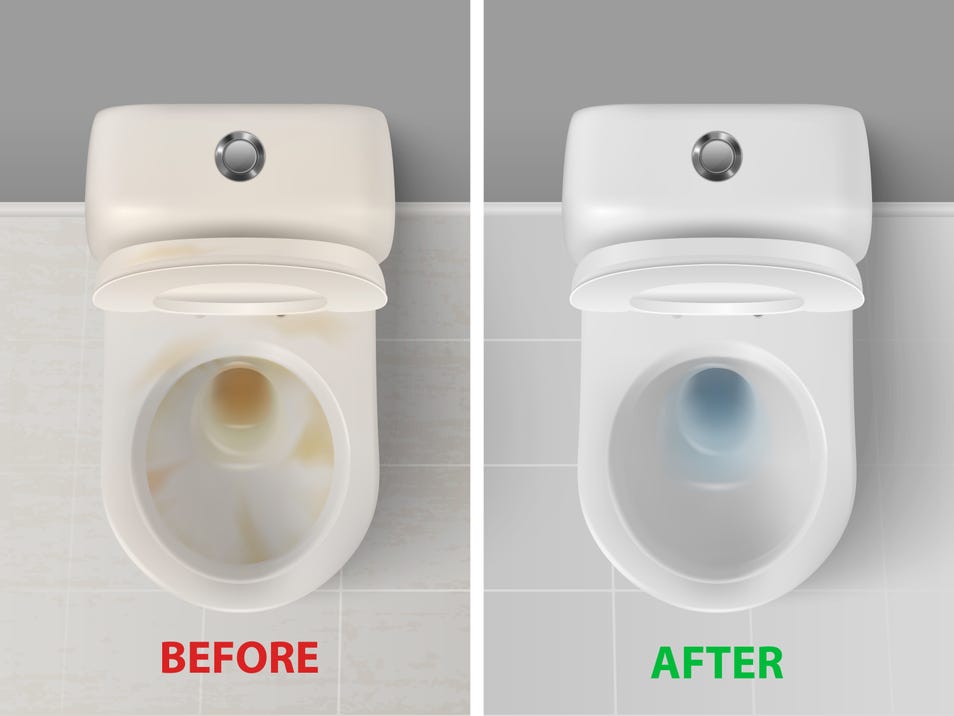How To Remove Limescale From Toilet - Quick and Easy Steps

How To Remove Limescale From Toilet - Quick and Easy Steps
The toilet, a place that is used to maintain hygiene and cleanliness, can often become challenging to keep clean due to limescale buildup.
This troublesome culprit that tarnishes the toilet's appearance and affects its functionality is formed by the magnesium and calcium left behind after the hard water evaporates, which tends to cling to our toilet bowls, resulting in discoloration, pipe blockages, cracks, and improper flushing over time.
So, if you are experiencing a limescale problem in your toilet, fret not. Keep reading our guide on how to remove limescale from toilets, where we provide quick and easy step solutions to this problem and share useful bathroom cleaning tips to maintain a clean and hygienic toilet.
What is limescale?
Limescale, a mineral deposit composed of calcium carbonate, is a chalky substance that builds up on anything it comes into contact with. When hard water with high mineral content evaporates, it leaves calcium and magnesium deposits on the surface, resulting in limescale formation.
Over time, this stubborn buildup can lead to discoloration, reduced flushing efficiency, blockages, and unpleasant odor. Understanding the causes and factors contributing to limescale formation empowers you to effectively combat and prevent its buildup, ensuring a clean and well-maintained toilet.
How to remove limescale from toilet
Step 1: Pour the toilet cleaner
The initial step in combating limescale in the toilet begins with pouring vinegar, bleach, or a reliable and trusted Powerplus Original, which removes 100% limescale, tough stains, and 99.9% of germs and bacteria.
Apply the solution generously to the limescale-affected areas, allowing it to sit for a few minutes, giving ample time to penetrate and break down the stubborn buildup.
The acidic agents weaken the grip of limescale on the surfaces, making the subsequent cleaning process more manageable and yielding impressive results.
Step 2: Scrub the toilet bowl
Now that you have let the cleaning agent do its work, it is time to pick up the toilet brush and give your toilet bowl a good old-fashioned scrubbing. If limescale stains persist, consider adding more cleaning agents during scrubbing to enhance its effectiveness.
Step 3: Flush the toilet
After scrubbing and removing all limescale, flush the toilet several times to eliminate residual toilet cleaner/bleach/vinegar and mineral deposits. This final step guarantees a clean and refreshed toilet bowl, free from traces of limescale buildup.
Removing limescale with sandpaper or pumice stones
Sandpaper
While using medium-grain sandpaper to wear down limescale is an option, we advise against this method on a recently-purchased toilet, as it may potentially damage your toilet surface.
However, you can use this method on a relatively old toilet, but exercise caution not to apply excessive pressure. Once you finish, you can easily flush away the residue and continue your regular cleaning routine.
Pumice stone
You can harness the natural abrasive power of pumice stone for removing limescale, hard water stains, and calcium deposits in the toilet. Simply dampen the pumice stone and the toilet and apply gentle pressure in straight motions. Again, we wouldn't recommend using this method on a recently purchased toilet, as it may potentially damage your toilet surface.
FAQs
How often should I clean my toilet to prevent limescale?
To prevent limescale buildup, it's advisable to clean your toilet at least once a week. Frequent toilet cleaning using Harpic toilet cleaners helps stop limescale, tough stains, and germs from accumulating in the toilet.
Can limescale damage toilet components?
If not removed regularly, limescale deposits can cause minor to major problems, including pipe blockages, cracks, and improper flushing.
What causes limescale buildup in toilets?
Hard water, containing large amounts of minerals like calcium and magnesium, causes limescale buildup in toilets. When hard water evaporates, it leaves behind minerals that react and form a hard, chalky-like buildup known as limescale.
.png?width=70&height=88&format=png&quality=50)